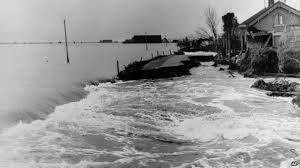As if I really have to explain beyond that first word.
I have an instant array of images upon the mention of Dutch.
The strongest is the National stereotype of a nation wearing only bright orange attire on the occasion of any event from the World Cup to the Olympic Games and The Tour de France to Eurovision.
That is followed by yet more cliched attachments that are synonymous with the identity of that proud country of windmills, tulips, upright bicycles and, unfortunately, a liberal recreational drug culture.
My first childhood perceptions were based on a bedtime story of the small boy who put his finger in the huge dyke wall and so saved the whole country from a disastrous flood.
It was not however a fairy tale or fictional invention because it is a hard fact of life for the Dutch that theirs has, for centuries, been an existence very much at the whim of the waves and tides of the rivers and seas that surround and bisect it.
Fifty five percent of the land mass of Holland and sixty percent of its population are below sea level and in economic terms that translates to well over half of the Gross Domestic Product.
The constant threat of inundation has however brought out the best in terms of inventiveness and resilience in the Dutch in their attitude towards water.
It has been a harsh reality and in 1953 the tidal surge which also swept along the East Coast of Scotland and England caused catastrophic floods in the Netherlands and with more than 1800 fatalities.
This prompted a State funded range of projects, in effect a huge finger in the dyke equivalent with a series of dams and surge barriers to strengthen the vulnerable coastline.
In 1993 and 1995 the problem was not from the sea but a build up of flood levels in the rivers that flow across the land mass towards their outfalls in the North Sea.
The network of dykes managed, just, to hold back the water but not before a quarter of a million residents had been evacuated. You cannot accuse the Dutch Government of complacency as this sharp intake of breath at a narrow escape prompted a major rethink of strategy not so much to contain and suppress the natural forces but to work with them.
Innovative ideas included creating space for controlled flooding rather than adding a bit more onto the top of the existing defence walls. Channels and spillways were formed to divert surplus water into designated zones. This did mean that compulsory purchase powers were used to acquire homes, businesses and farms in order to ensure that no one resisted and stayed behind to be at risk of danger or a liability for rescue. There has been an ecological price to pay for public protection on this scale. The post 1953 phases of surge barriers and walls caused stagnant water conditions and a decline in the habitat of shellfish and marine mammals. That is another example of the pragmatism of the Dutch.
Other more recent projects to cope and co-exist with the threat of floods have included floating panels to act as a self closing flood barrier, an army of volunteers to slot in metal planks to stop up any gaps in existing defences in the event of potential flood conditions and an impassable bridge at high water to make citizens aware of dangerous conditions and to ensure that they do not attempt a crossing.
In housing the imagination of Architects has led to the building of homes in risk areas on a system of hydraulic piles that rise and fall under flood conditions. Conventionally built houses have a lower ground floor that can be surrendered to any flood levels to later be dried out and returned to full use with as little as disruption possible to its occupants. Other residences simply float.
The Dutch have, over centuries, had to self educate in matters of flood control and alleviation but above all have remained realistic that there is a good chance on a daily basis of defences being overwhelmed.
Huge projects and investment have meant that one small boy and his finger have been able to go on and make something of his life without the pressures that come with being on call as the saviour of a Nation.
Source; Sweet and Salt, Water and the Dutch by Tracy Metz



No comments:
Post a Comment